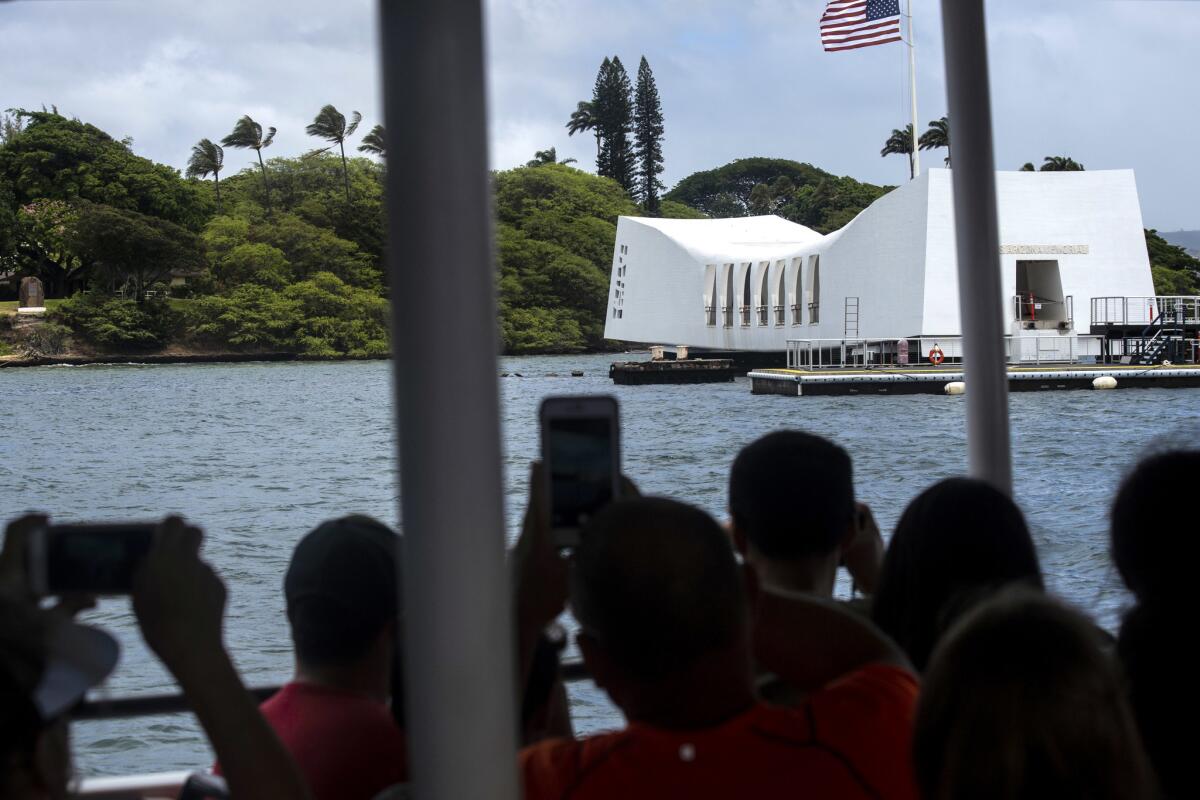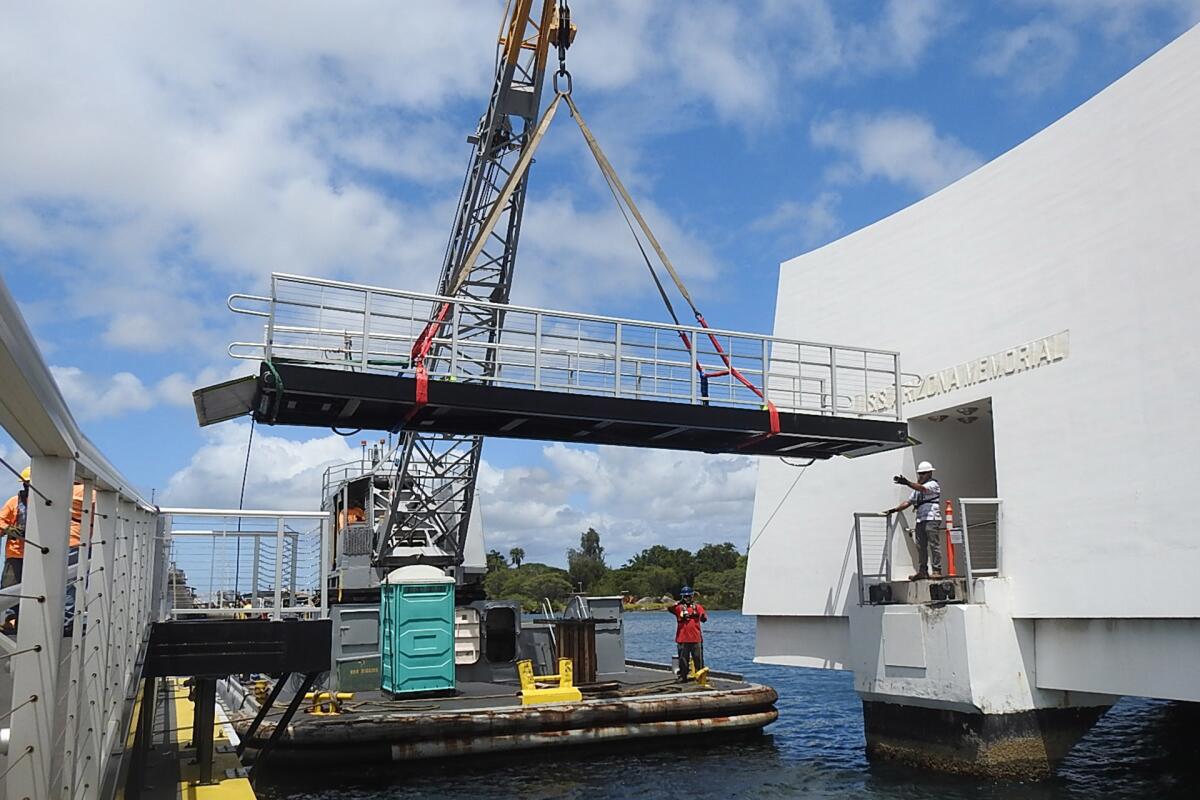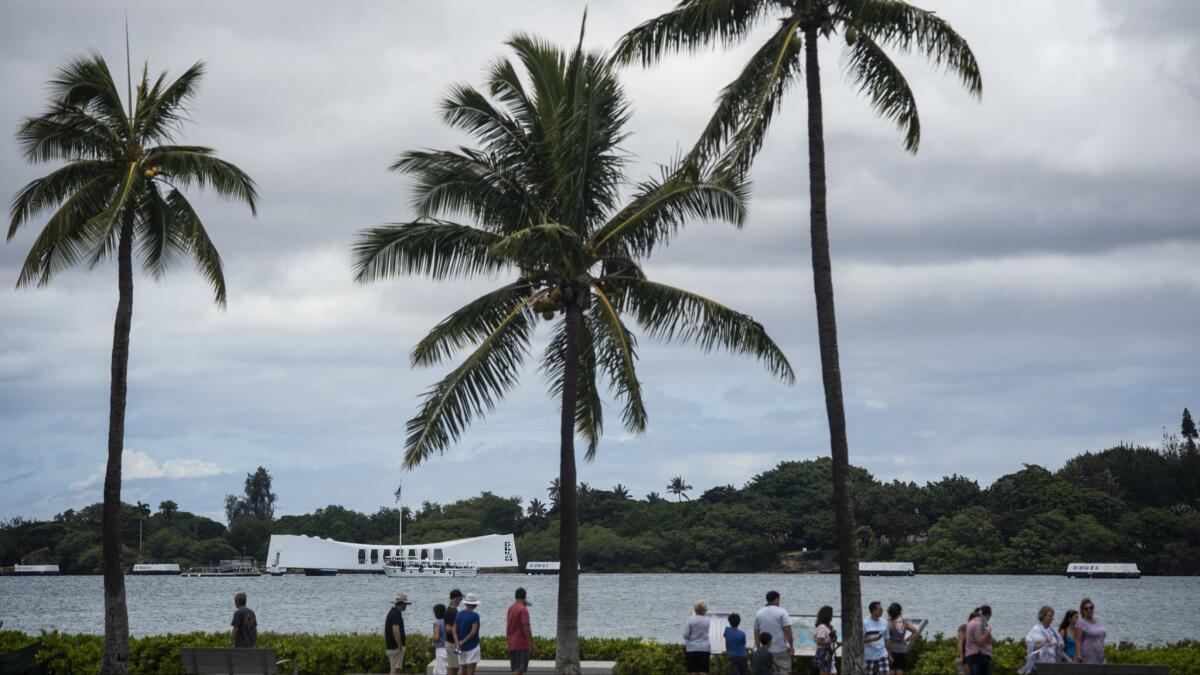USS Arizona Memorial, watery grave of Pearl Harbor sailors, remains closed as officials mull repairs

- Share via
As the nation celebrates the Fourth of July, thousands will visit Pearl Harbor to learn about the surprise attack Japan unleashed on Dec. 7, 1941, and to pay tribute to those who lost their lives in the battle that hurled the United States into World War II.
However, this year, tourists won’t get to set foot on one of the most revered sites here, the USS Arizona Memorial, which has been closed since May 6 over safety concerns.
The National Park Service had hoped to reopen the site by the holiday, but it’s taken longer than anticipated to figure out how to repair the dock that allows visitors to board the memorial, which rests on pilings over the sunken battleship. The memorial is one of the most-visited tourism sites in Hawaii, and it’s unclear when it will be reopened.
“The problem is the anchoring system that holds the dock in place has partially failed,” said Jacqueline Ashwell, the superintendent for the WWII Valor in the Pacific National Monument.


The floating dock has been moving as much as 10 feet away from the memorial, when it’s only supposed to move about 2 feet. The dock is anchored by chains attached to concrete blocks embedded in the harbor floor, about 50 feet deep. Any repair work must be done very carefully.
“The anchors are in a very sensitive location right next to the wreck of the USS Arizona, where more than 900 men are entombed, and there is a possibility that unexploded ordnance from the Dec. 7, 1941, attack is under the water and buried in the sediment,” Ashwell said.
The memorial honors the crew of the Arizona as well other Americans killed in the attack — 2,341 service members and 49 civilians. The bombing of the Arizona left 1,177 crew members dead, the greatest loss of life on a U.S. battleship, according to the Navy.
Ashwell said the Park Service is close to choosing a repair solution. “Our repair strategy will likely involve placing some additional anchors in the harbor to pull the dock back into place,” she said.
The closure is the longest the memorial has ever been off limits to the public, and has led to misperceptions about the problem. One tourist had heard the memorial had been hit by a cargo ship. It wasn’t.
“Some people think the memorial is structurally damaged, but it’s not,” Ashwell said. Some minor damage occurred when the dock was pulling on the access ramp, chipping the concrete where the memorial and ramp meet. But that can easily be repaired.
“When people hear that the memorial is closed, there’s a misconception among many that the Pearl Harbor Visitor Center is closed,” said Jay Blount, spokesman for the WWII Valor in the Pacific National Monument. However, the center remains open, and Blount pointed out people can still tour all the other historic sites in the area, including the Battleship Missouri Memorial, the USS Bowfin Submarine Museum and Park, and the Pacific Aviation Museum Pearl Harbor.

At the visitor center, people watch a 23-minute-long documentary on the attack and then take a narrated harbor tour around the memorial and the area known as Battleship Row. Even without setting foot on the memorial, where the names of the fallen are engraved and painted on a marble wall, recent visitors said the harbor tour remains profoundly moving.
“We got close to the Arizona and could see the wreckage,” said Steve Van De Beuken, who came with his family from Tucson, Ariz. “The whole thing felt surreal, and I could picture what it must have been like to see the planes coming in.”
For David McNamara, who came with his wife, Melissa, and three kids from Chatham, N.J., their visit made him think of his grandfather, who served in World War II. “To watch the real actual footage in the movie put today’s world in perspective. The freedom we get to enjoy today is because of the sacrifices young men and women made to serve our country,” he said.
Even though JoAnn Matsunaga and her husband, Andy, from Simi Valley had visited the memorial years ago, they came once again to learn and reflect.
“My parents got married just before they were forced into internment camps. While my dad was serving in the Military Intelligence Service, my brother was born at Manzanar. My father served his country, while his wife and son, parents and relatives were all incarcerated. They were uprooted and had no choice,” said JoAnn Matsunaga, noting that about 120,000 people of Japanese descent — most of whom were Americans born in the United States — were imprisoned.
For Andy Matsunaga, their visit brought back memories of his father, who was in Pearl Harbor on that fateful morning. “A bomb went through the Quonset hut where he was working as a civilian welder,” he said. “But apparently it was a dud, and didn’t explode.”
Over the last year, 1.95 million visitors have come to the USS Arizona Memorial, making it the second-most-visited destination in the Aloha State. Hawai’i Volcanoes National Park remains the state’s top tourist attraction, but most of the park is closed because of volcanic activity in a small area of the Big Island.
The Arizona memorial was built in 1962 and designed by architect Alfred Preis. Many helped raise money to build the gleaming white structure. Its best known donor was Elvis Presley, who performed at a benefit concert at Pearl Harbor in 1961.
The rectangular structure is about 184 feet long and rises at both ends, but sags in the middle. The Pearl Harbor Visitors Bureau’s website on the memorial explains the symbolism behind the design: One peak represents the country’s pride before the war. The sag represents the “shock and depression” the U.S. felt after Pearl Harbor. The second peak represents America’s might and rise to power after the war.


Visitors to the memorial often bring flowers, and many report seeing unexpected movements in the water that are surprising and deeply moving. The battleship still contains oil, and small amounts bubble to the surface seven decades later.
“It’s a solemn place. You see all the movies and documentaries, but until you go there and see it, that’s when it really hits home. You get a better understanding,” said Tom Polston who came with his wife, Kathy, from Odessa, Texas. “We were thrilled to visit Pearl Harbor. Even though it was disappointing that we didn’t go on the memorial, I wasn’t disappointed that we went to the Pearl Harbor Visitor Center and saw all the sites.”
He added, “All my life I wanted to go to Pearl Harbor, not just to see the Arizona. And there’s still a lot to see, like the airport hangars that still got bullet holes in the glass doors from the day of the attack. ‘Wow, I’m standing right here where it all happened.’ It really makes you think and you feel sorry for the people who lost their lives.”
Even for those who work at the national park, the site inspires them daily. Ashwell, the superintendent, recalled one extraordinary moment that stands out:
“I had the honor of escorting President Obama and [Japanese] Prime Minister [Shinzo] Abe to the memorial on Dec. 27, 2016. Aside from Dec. 7, 1941, I think it was arguably the second most important day in Pearl Harbor's history.
“It was the first time that a Japanese prime minister and a sitting U.S. president had walked together on the USS Arizona Memorial. Being there with them on that day helped me to realize that we can overcome disagreements, even after both sides have made devastating decisions affecting millions of people. It gives me hope for a peaceful future for our planet."

Chang is a special correspondent.
UPDATES:
July 4, 12:10 p.m.: This article was updated to add that most of those forced into internment camps after the attack on Pearl Harbor were Americans born in the United States.
This article was originally published at 3:05 p.m. on July 3.
Sign up for Essential California
The most important California stories and recommendations in your inbox every morning.
You may occasionally receive promotional content from the Los Angeles Times.







